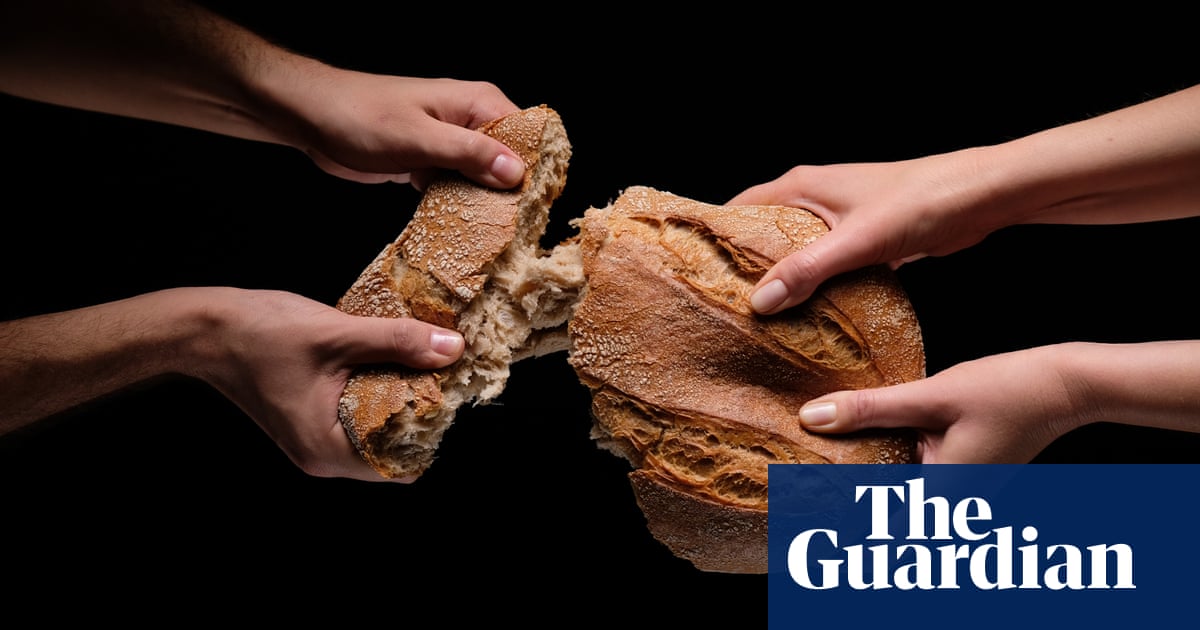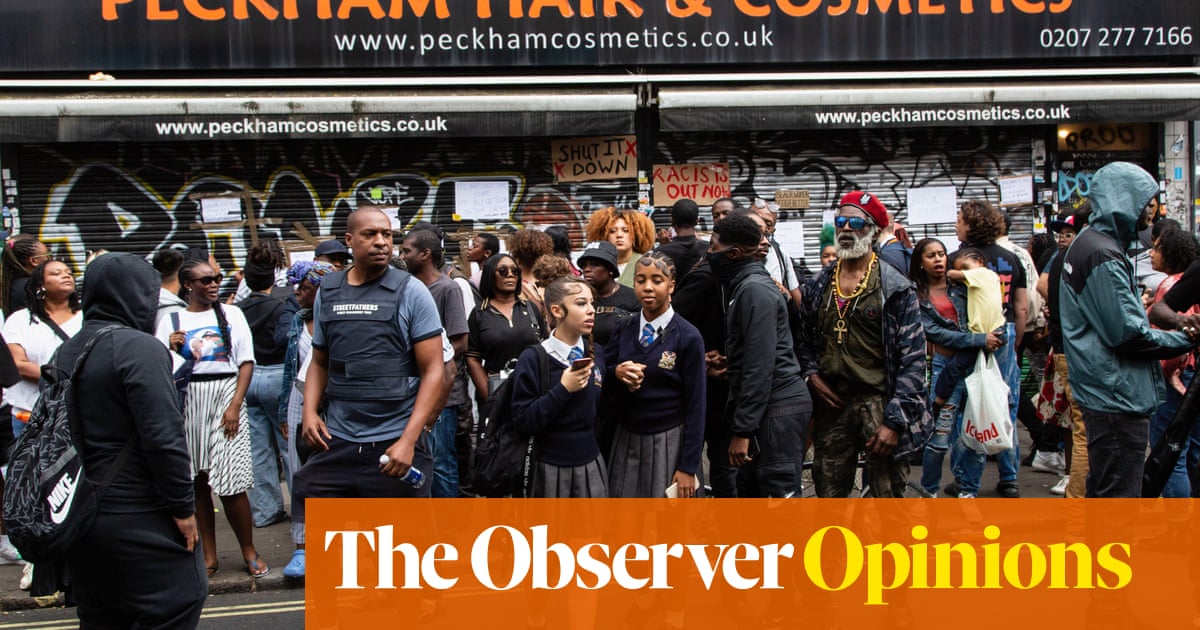
The cheapest loaf in my nearest supermarket costs 45p. The cheapest loaf in my local artisanal bakery costs £5. Which of these facts winds you up?
For Giles Yeo, a professor of molecular neuroendocrinology at the University of Cambridge, it is the £5 sourdough. Writing in the Guardian this month, he railed against “bougie” bakeries charging more for “fancy” bread. For Chris Young, the coordinator of the Real Bread Campaign, it is the 45p white sliced. In response to Yeo’s article, he pointed out that ultra-processing enables supermarkets to sell bread so cheaply.
This was just one recent spat in Britain’s long-running bread wars. It prompts two questions: how can something that requires only four ingredients – flour, water, yeast and salt – diverge so wildly on price? And how did our most basic foodstuff become so divisive?
Pen Vogler, the author of Stuffed, says it is precisely because bread is fundamental to our diets. “For good or ill, we have decided, on our rain-soaked island, that wheat bread is our staple,” she says. “Bread has been divisive from our earliest records.”
Like so many things, it is tied up with class. In her previous book, Scoff, Vogler wrote: “Ideas of social status and the colour of your bread go back to Roman times … the lord’s bread was snowy white and it was up to the rest of the household to ‘know the colour of their bread’ and therefore their place.” It took time – and money – to produce white flour. “The culture wars were always about white bread versus brown,” says Vogler.
Technology has since relegated white sliced to the cheapest option. Wheat used to be crushed between stones to make flour, mixing the bran, germ and endosperm together, which could then be sieved to make it whiter. Then, in the 1870s, came steel rollers that ripped off the brown bran and oily germ, making white flour in a flash. Workers had access to white bread for the first time. “After being told for centuries that white bread was too good for the likes of them, it isn’t surprising that easy-to-eat, comforting white bread is what people wanted,” wrote Vogler.
Another gamechanger was the advent of the Chorleywood bread process (CBP) in the 1960s. High-speed mixers slashed the time it took to make a loaf; instead of having to wait for the dough to rise, it was instantly ready to bake. Suddenly, factory bread was the fastest – and cheapest – around.
Today, it is estimated that 80% of British bread is produced using the CBP and another 15% by other automated processes in supermarkets’ in-store “bakeries”. Only 5% comes from craft bakeries – and some of those may use additives.
What went so wrong? Let’s start with the flour. My £5 sourdough contains regeneratively farmed flour. It comes from locally grown, micronutrient-rich heritage wheat varieties sown in grass, alongside other plants and grazing animals, without the use of pesticides or heavy machinery. The wheat in my 45p loaf is a modern hybrid bred for its high yield and tolerance to pesticides, grown in a monoculture.
The £5 loaf’s wheat is stoneground into wholemeal flour, which, as it uses all parts of the grain, retains its protein, vitamins, fibre and healthy fat. (Cyclone milling is a more modern alternative.) The 45p loaf’s wheat is roller-milled into white flour. This removes almost all the vitamin E and depletes a host of other vitamins and minerals. A handful are added back – calcium, iron, thiamin, niacin and soon folic acid, too.
Next come water, salt and yeast. The white sliced requires large amounts of water, is high in salt and needs more yeast than traditionally made yeasted bread. The sourdough, on the other hand, contains no baker’s yeast (unless it’s a supermarket sourfaux) and is instead made using a live sourdough starter – a flour and water mix containing the yeasts and lactic acid that live on the surface of cereal grains. This needs a much longer fermentation time before baking, which a growing number of studies suggest brings health benefits, including increased B vitamins and antioxidants, lower levels of acrylamide (a naturally occurring chemical that can increase the risk of cancer) and a lower glycaemic index, although more research is needed.
Ingredients-wise, there is nothing else in my £5 loaf. The label on my 45p loaf, however, lists a preservative, emulsifiers, vinegar, rapeseed oil and a flour treatment agent. The manufacturer is not required legally to list the various “processing aids”, usually enzymes, used mainly to increase volume and prolong softness. “Industrial bread is the poster child of ultra-processed food,” says the Real Bread Campaign’s Young. “It’s made using a whole cocktail of additives.” The world’s largest review into ultra-processed food found last month that it is “directly linked to 32 harmful effects to health, including a higher risk of heart disease, cancer, type 2 diabetes, adverse mental health and early death”.
Surely the “healthy” loaves in the supermarket are OK? Hovis Seed Sensations (£1.90) is one of Waitrose’s bestselling breads, promising omega-3 and protein from its blend of six seeds. I ask Chris van Tulleken, the doctor and author of Ultra-Processed People, to take a look at the label. It has all the hallmarks of an ultra-processed food: preservative, emulsifier, flour treatment agent. But, says Van Tulleken, “the ultra-processing is just one aspect of it. Even if you don’t care about that, according to UK dietary guidance, this bread is high in salt and sugar … At 278 calories per 100g, it has a higher calorie density than a Big Mac. It is also incredibly soft.”
Softness gives bread the illusion of freshness and makes us eat more of it. The trick can work in reverse, too. In the two world wars – and even as far back as the Napoleonic wars – British bakers were banned from selling soft, fresh bread. It was known that firmer, older bread filled people up more, so they needed to eat less of it. This was a good thing when food was scarce – and it could be today amid an obesity crisis.
“Let’s think hard about growing and consuming less, better wheat,” says Andrew Whitley, the co-founder of the campaigning, growing and baking project Scotland the Bread. “If we can eat fewer slices of more satisfying bread, we take pressure off our belts, our food budgets and the natural world, where biodiversity loss from intensive grain farming is as big a crisis as climate breakdown.”
Of course, that doesn’t mean we all have to spend a fiver on a sourdough. The Real Bread Campaign defines “real bread” simply as having no additives. “Sourdough is the oldest way of making bread, but some people shun it because they think it’s elitist. Others deliberately make it elitist,” says Young. “Bakers on Instagram posting pictures of sourdough with lots of holes are part of the problem,” adds Whitley. “This is about feeding people healthily on the basis of food justice and inequality. It’s not about creating a hipster brand.”
Sourdough is a method, not a style. Almost any kind of bread can made this way: brioche, pizza bases, rotis, croissants. Still, there is no getting away from the fact that sourdough, and other real bread, is expensive.
Is home-baking the answer? “Making your own is a glib middle‑class response,” says Young. “Someone working 14-hour shifts is going to struggle.” Ditto people with limited cooking facilities or skills, or no access to good ingredients.
Still, the sourdough craze during the pandemic showed that, given the time, bread-making can be very rewarding. “It’s the alchemy,” says Young. “You take three ingredients and make something amazing and delicious.” For Whitley, who has campaigned for real bread for decades, the rise in baking is heartening. “More people are baking better bread,” says Whitley. “Some are even starting their own businesses, from nano-bakeries to full-scale artisanal bakeries.” (The bakery behind my £5 sourdough was born in lockdown.)
For those short of time or skill who want to bake at home, the Real Bread Campaign has called a bread machine amnesty – apparently, 1.4m are languishing in kitchen cupboards. It is encouraging people to use them or give them to someone who will. That still leaves a lot of people who want to pop to the shops and buy a decent loaf without spending 10 times more than they do normally. How can we bridge the gap between the 45p white sliced and the £5 sourdough?
During the second world war, bakers could legally produce only a regulation loaf. “This ‘national loaf’ was subject to its own culture wars,” says Whitley. “Some referred to it as ‘our murdered bread’ because it contained no wheatgerm.” At the other extreme, says Seamus Higgins, an associate professor of food process engineering at the University of Nottingham, “the national loaf was sarcastically nicknamed ‘Hitler’s secret’ by people who were used to eating white bread. It was heavy and greyish beige in colour, crumbly in texture and stale by the time it was purchased.” Both agree that this high-fibre loaf, however controversial, was nutritious and helped to improve public health.
While no one wants a return to grey wartime bread, Whitley thinks there is scope for a new, improved people’s loaf. He envisions that it would be made from locally grown, organic wheat; contain at least 75% wholemeal flour; be low in salt; and contain no additives. It could use either baker’s yeast or a sourdough starter and be produced in all shapes and sizes, from a tin loaf to flatbreads, rolls and batons. The vision is “a nutritious, affordable and accessible bread for everybody”, he says.
Meanwhile, some craft bakeries have “real bread for all” schemes to make their products affordable. Hart’s and Batches bakeries in Bristol have teamed up to make an artisanal bread similar to the white sliced many people are used to, but with 15% wholemeal flour and no additives. They subsidise the loaf and sell it for 75p from a mobile food shop in the BS13 postcode area, where one in eight households live in extreme food insecurity.
Aston’s Bakehouse in Berkshire sells a people’s loaf for £3.40, nearly 30% less than its next-cheapest sourdough. To keep the price low, it is made from semolina, a milling by-product, as well as wholemeal flour. In the north of Edinburgh, all bread at the Granton Garden Bakery is sold on a “pay what you can afford” basis.
Can traditional baking can be done at a scale to feed everyone? Other countries suggest it is possible. “Decades ago, I visited a factory in Russia making 100 tonnes of really good sourdough rye bread a day,” says Whitley. “They had simply scaled up exactly what a home or village baker did.” Young says: “We go on holiday to France or Italy and there seems to be real bread on every street corner. There is an element of rose-tinted spectacles. But, generally, the percentage of small, independent bakers is smaller in the UK than in France, Germany or Italy.”
No one really knows why. Early industrialisation played a part, but Germany wasn’t far behind Britain and its pumpernickel is still made properly. France is the most interventionist country, says Higgins: the 1993 décret pain (bread decree) states that baguettes must be made on the premises where they are sold and can be made only with wheat flour, water, salt and yeast.
Lots of Britons grew up on white sliced and never lost their taste for it. “We love the sweetness and softness,” says Whitley. “My mum used to bake wholemeal bread and I would escape to friends’ houses to eat white sliced.” Now, he thinks white bread should be an occasional treat. Young agrees: “We all had things we liked as children, but these things aren’t necessarily good for us as adults.” The point is, industrial bread is often the only option. “We don’t want to ban white sliced,” he says. “We want people to have the chance to choose an additive-free, high-fibre, preferably wholemeal, loaf.”
Whitley adds: “With white sliced being so cheap and hiding the reasons why it’s so cheap – growing conditions, labour conditions, emissions – people are not able to make a reasoned choice,” says Whitley. “We’ve been doing this to poor people for 250 years. It’s a matter of radical injustice.”
Vogler says cheap bread is symbolic of our broken food system. Others go further and argue that it reflects our splintered society. “The No 1 problem is poverty and inequality,” says Van Tulleken. “The food industry is very skilful at appearing to be an ally of the people who are forced to eat its products … To criticise the gambling industry is not to stigmatise the gamblers. The focus of my critique is those individuals and institutions who could regulate this industry but fail to do so – charities, politicians, scientists and doctors who partner with companies that harm health.”
Protest can bring about real change, says Vogler: “In the 19th century, bread used to be adulterated with alum, plaster of paris, talcum powder … People who could only afford the cheapest bread were eating absolute rubbish. The Lancet [medical journal] and the middle classes made such a fuss about it that eventually the government introduced labelling laws.” The Sale of Food and Drugs Act 1875 still forms the basis of food law in the UK.
Maybe we can all agree that 45p is no bargain for an ultra-processed product and that £5 for a sourdough loaf prices out most people. “We need a grassroots revolution,” says Whitley.
For once, it is hard to argue.
This article was amended on 20 March 2024. An earlier version erroneously attributed a quote about the “alchemy” of bread to Pen Vogler, rather than Chris Young.












